
written by Kaitlynn Fenley
My easy fermented fruit vinegar recipe requires only three ingredients: fruit, sugar and water. This is the perfect recipe to use up fruit scraps, overripe fruit, and any fruit you have in abundance. You can use this recipe to make homemade apple cider vinegar, apple scrap vinegar, berry vinegar, and more!
How do You Make Vinegar?
Vinegar is made via a two-part fermentation process. First, yeast consuming sugars within fruits and grains and produce alcohol; this is known as alcoholic fermentation.
Second, acetic acid bacteria consume the alcohol from step one and convert it into acetic acid. Once all the alcohol is metabolized by bacteria and converted into acetic acid, you have vinegar.
To make vinegar at home, you first essentially make wild fermented fruit wine, and then that wine turns to vinegar!
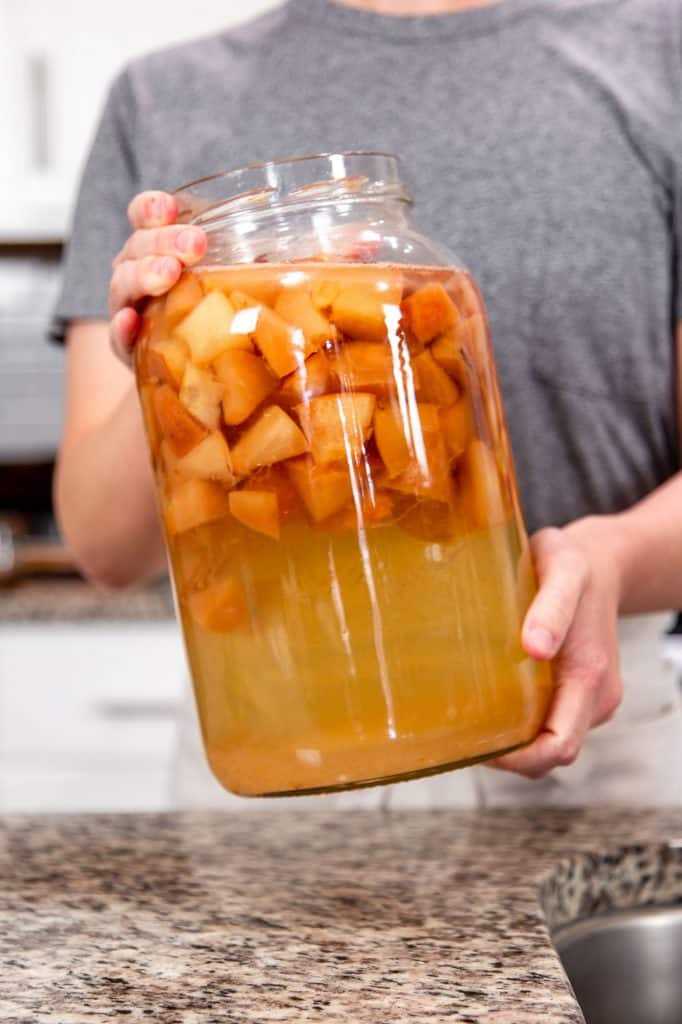
It is the floaty white pieces in between the apples.
How to Make Vinegar from Fruit
It is so easy to make vinegar from fruit. You only need three ingredients: fruit, sugar, and water. It helps if you have some raw apple cider vinegar with the mother as a starter, but it is not necessary.
You can use pretty much any type of fruit to make vinegar. I suggest sticking to high fructose fruits and staying away from high-sorbitol fruits. These are two types of fermentable sugars found in fruits, and high sorbitol fruits tend to cause kahm yeast.
These are my favorite fruits to use:
- apples
- pears
- mango
- strawberry
- grape
- figs
- watermelon
To make vinegar from fruit, you just need a good bit of whatever fruit you want to use, water, and some organic cane sugar. You also need a large glass jar.
For this recipe, I suggest a gallon glass jar and a cloth cover with a rubber band. You have to use a cloth lid when making vinegar because acetic acid bacteria require oxygen to convert alcohol into acetic acid. I usually make cloth lids for fermentation by cutting up old t-shirts.
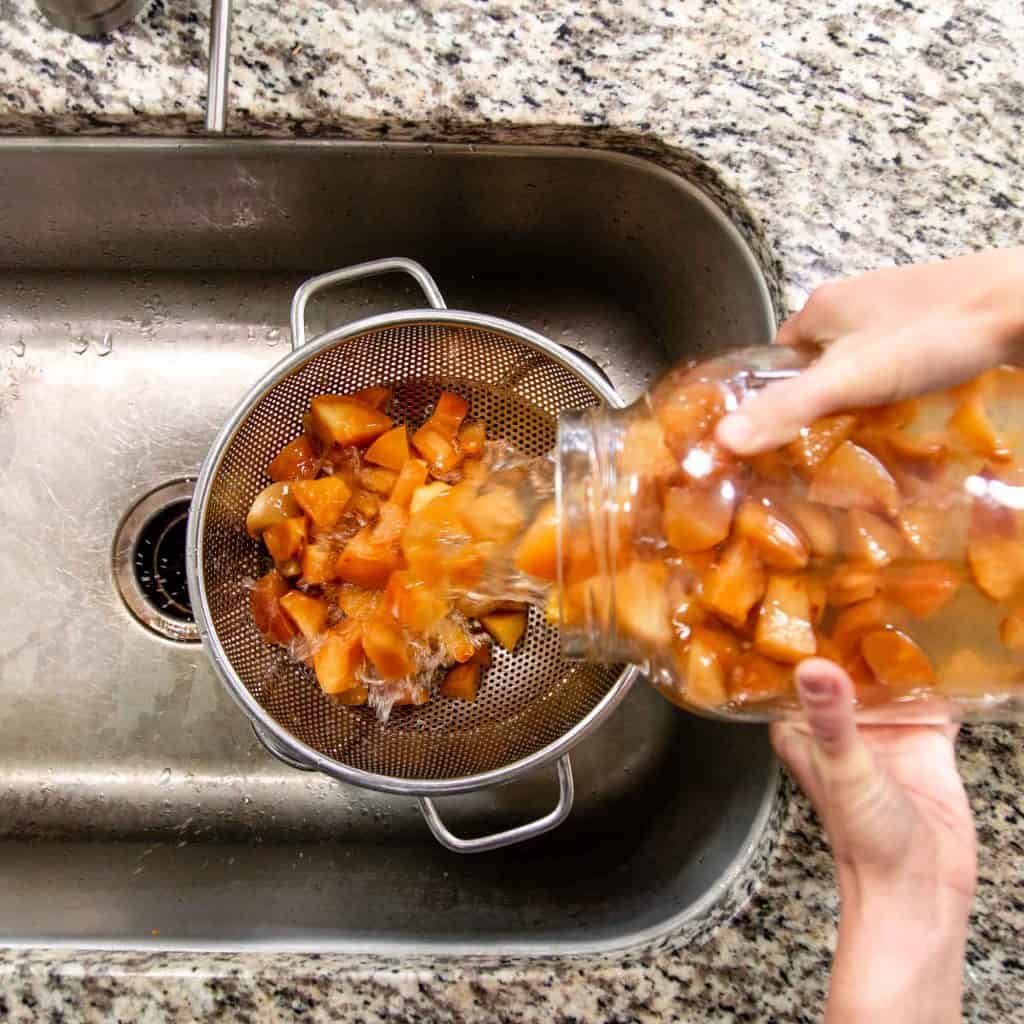
How to Make Apple Cider Vinegar
There is a slight difference between apple cider vinegar and apple scrap vinegar. The recipe in this blog post is more similar to an apple scrap vinegar, even though I use the whole fruit and not just scraps.
In order to make “true” apple cider vinegar, you need to first make apple cider, and then change that apple cider into vinegar.
Once you make apple cider, you can turn it into vinegar by adding a vinegar mother and covering with a cloth lid. It should take about 4 to 6 weeks to turn the apple cider into vinegar.
I think my recipe (below) is easier and more functional for making vinegar at home. It’s definitely easier than going through the whole process of making cider first.
It is slightly less acidic than apple cider vinegar, but still delicious. Plus, this method is applicable to many types of fruit or mixes of fruits.
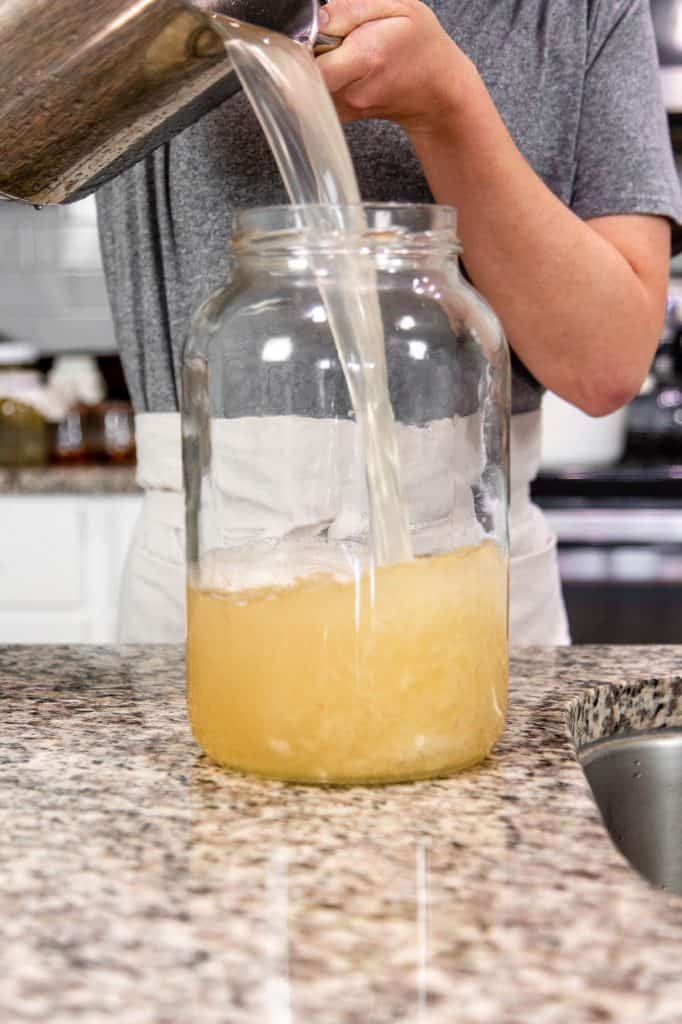
What is a Homemade Vinegar Mother?
Vinegar “with the mother” is another name for raw vinegar containing all the microbes from the brewing process. So, think of the mother as microbial cultures. Vinegar mothers form cloudy floating pieces within the vinegar and a SCOBY on the surface.
A vinegar mother SCOBY looks similar to a kombucha SCOBY but is often lighter with varying textures. Vinegar mothers in homemade vinegar are always unique. No two will look exactly the same because the wild microbes from fruit scraps will be slightly different across batches.
You can use the vinegar mother SCOBY from your first batch of vinegar to culture the next batch of vinegar.
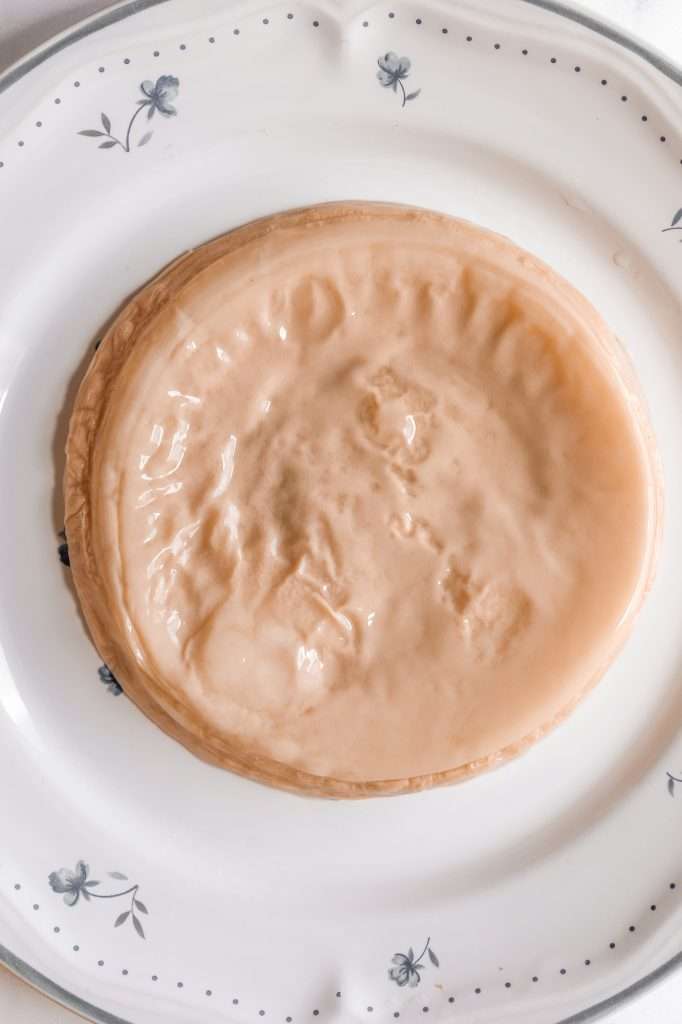
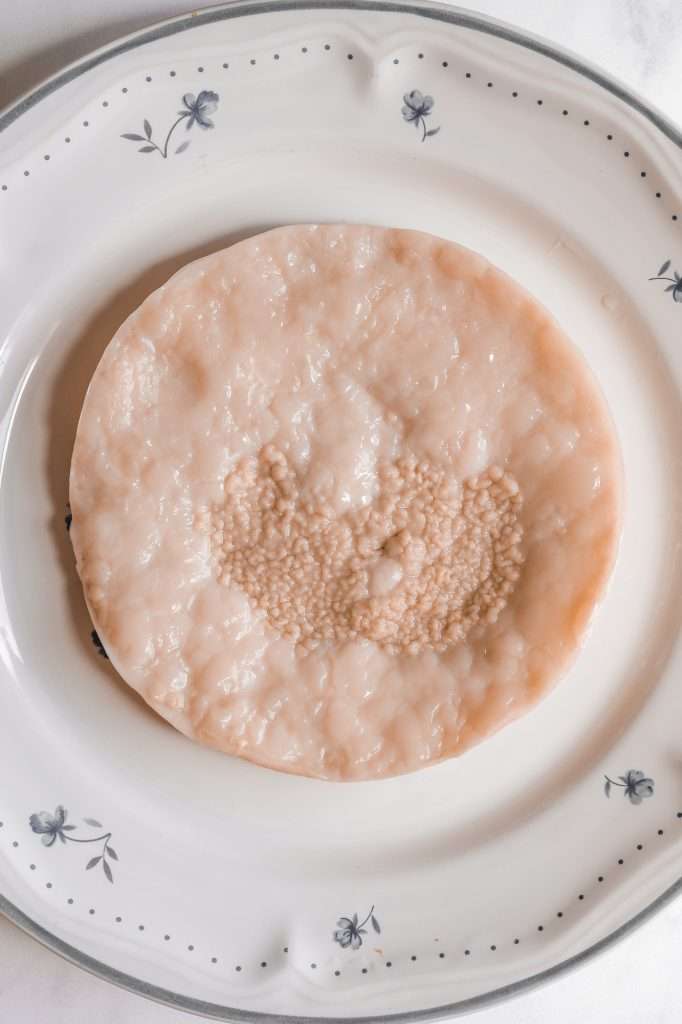
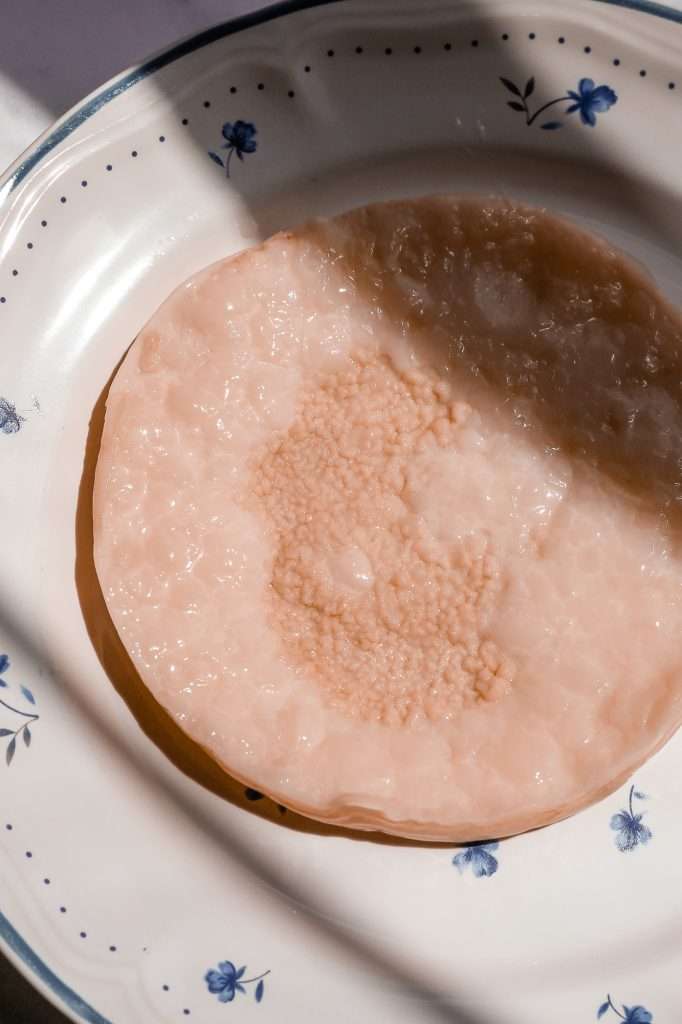
Homemade Apple Cider Vinegar
I still call the vinegar I make using this recipe “apple cider vinegar” when I make it with apples. It tastes almost exactly like the ACV I buy at trader Joe’s, and I bottle it in recycled apple cider vinegar bottles from the store.
The keys to remember when making ACV or any fruit vinegar at home:
- Stir the vinegar once daily. Remove the cloth lid, give it a good stir, replace the lid and repeat daily until you strain the vinegar.
- You must use a breathable cloth lid. The microbes involved in vinegar production require oxygen to convert alcohol to acetic acid.
- Use a clean glass container. It is best to use glass when fermenting acidic vinegar. Clean your equipment well before getting started.

What do you use fruit vinegar for?
I use my homemade fruit vinegar in any recipe where I would use store-bought vinegar. Since fruit varies in sugar content depending on ripeness, the acidity of each person’s vinegar will vary a bit depending on the fruit used.
It may or may not be adequate for pickling and canning pickles. To make a strongly acidic vinegar, you can use more sugar and use fruits high in fructose, like mangoes.
You can also test the pH with a pH strip to see if it is good for pickling/canning. Vinegar that is safe to use in pickling recipes should be approximately 2.4 pH (about 5% acidity).
Here are my favorite ways to use homemade vinegar:
- for homemade salad dressing
- with homemade bone broth
- in heirloom culturing recipes
- in mineral-rich hydrating drinks (I like to mix a tablespoon of fruit vinegar into a quart of water with a splash of coconut water, orange juice and a pinch of sea salt for a homemade hydrating “gatorade”)
- I love using my fruit vinegar to make Fermented Pickle de Gallo.
- You can also use homemade vinegar in Oxymel and Fire Cider recipes.
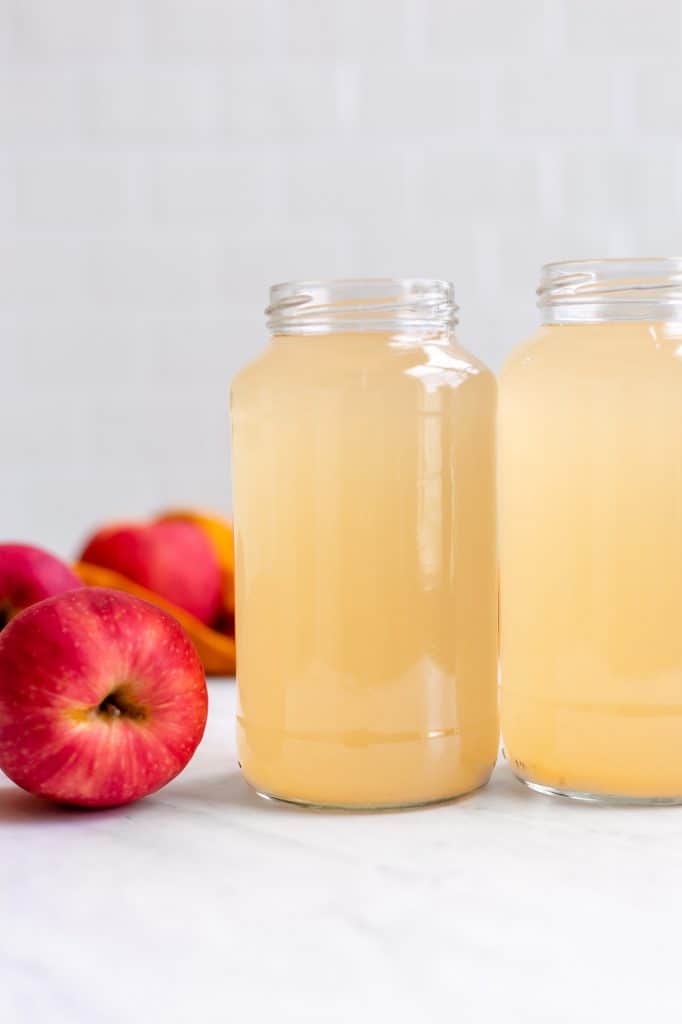
How to Make Vinegar from Scratch
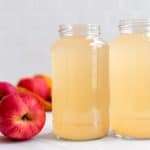
My easy fermented fruit vinegar recipe requires only three ingredients: fruit, sugar and water. This is the perfect recipe to use up fruit scraps and overripe fruit. You can use this recipe to make homemade apple cider vinegar, apple scrap vinegar, berry vinegar, and more!
- Author: Kaitlynn Fenley
- Prep Time: 10 minutes
- fermentation time: 9 weeks
- Yield: 1 gallon
- Category: Vinegar
- Method: Fermentation
Ingredients
- 6 cups of fruit*
- 255 grams of organic cane sugar
- Water
- 3 tablespoons raw apple cider vinegar with the mother
- 1 gallon glass jar
- cloth covering
- rubber band
Instructions
- Please read the recipe notes.
- Chop the fruit into small chunks.
- Add the sugar and apples (or other fruit) to a 1-gallon glass jar.
- Add water to the jar until full.
- Add in a few tablespoons of raw apple cider vinegar with the mother. This helps establish a good microbial community, and while it isn’t absolutely necessary to add I highly recommend it. If you’ve made vinegar before and have a vinegar mother, you can add it.
- Stir the mixture until all the sugar is dissolved.
- Place a cloth lid on the jar and secure with a rubber band.
- Stir the mixture once or twice a day and allow to ferment at room temperature for three weeks. Don’t forget to stir it. I like to just do it first thing in the morning each day.
- You should notice the mixture bubble within one week.
- After three weeks of fermentation, strain out all the fruit pieces, replace the cloth lid and allow the mixture to ferment for 6 more weeks.
- You will notice a vinegar mother form on the surface (it looks like a kombucha SCOBY but is very light in color). You can keep this to start your next batch of fruit vinegar.
- After fermentation, bottle the vinegar and seal it with a solid lid. Store at room temperature in your pantry.
Notes
- you can use any of your favorite fruits in this recipe. High fructose and fructan fruits tend to make the best vinegar. See a list of my favorite fruits above the recipe card. Use organic and homegrown fruit whenever possible. Conventional fruits sprayed with pesticides may not work well and may lead to kahm yeast.
- Vinegar works best with a starter culture. While it is possible to make vinegar without it, adding a vinegar mother or raw apple cider vinegar with the mother to the mixture ensures success. If you have a kombucha SCOBY or raw kombucha, you can sub for that with good results.
- For very strong vinegar, you can also add about a teaspoon of packaged cider yeast to the mixture.
Keywords: vinegar, apple cider, fruit